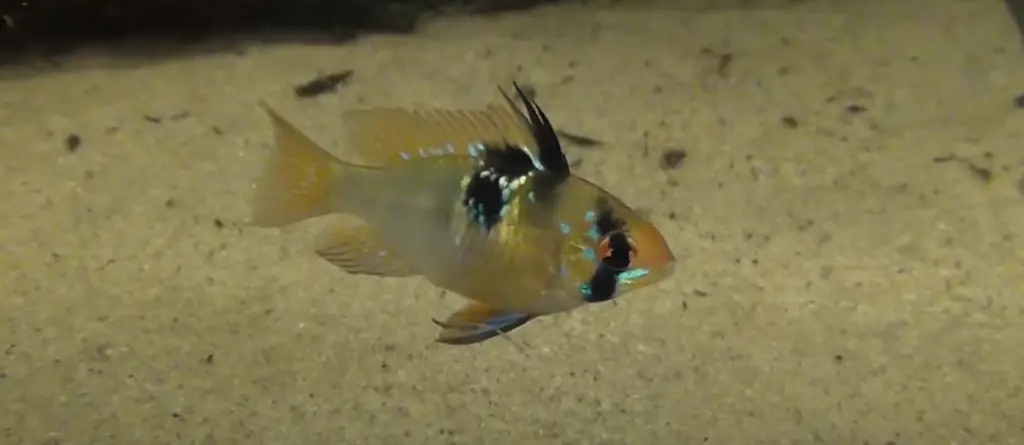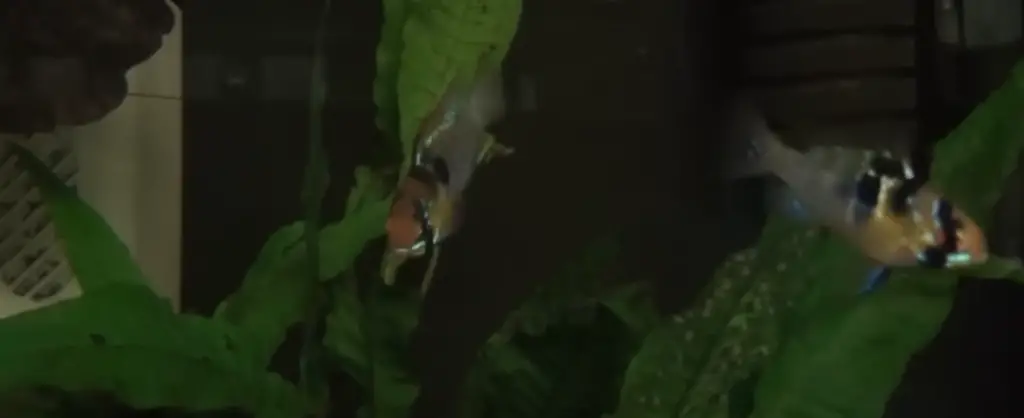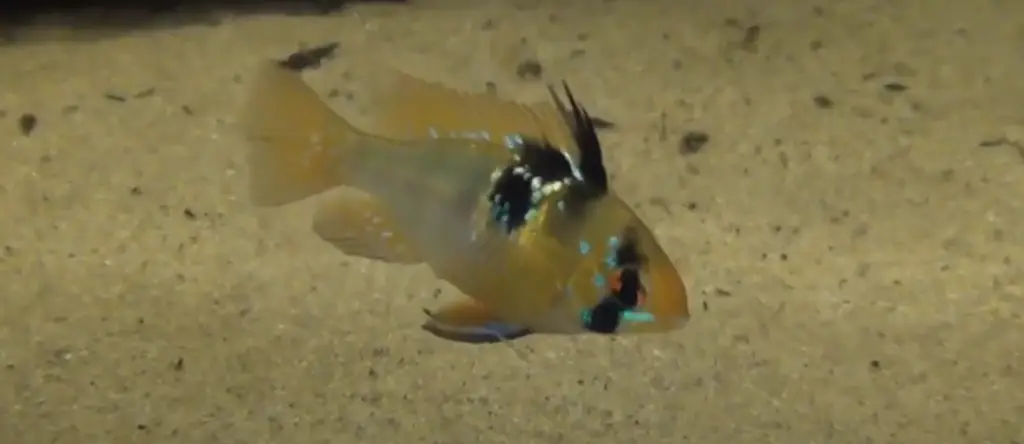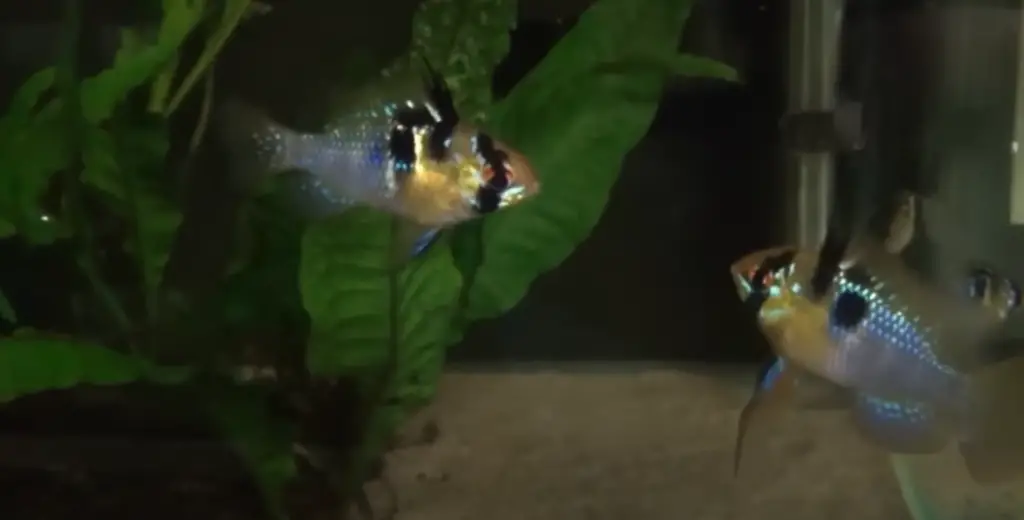In the nuanced world of freshwater aquaria, the German Blue Ram, Mikrogeophagus ramirezi, emerges as a species that captures the attention of hobbyists with its dazzling coloration and peaceful nature. As a dwarf cichlid, it adds a dynamic yet serene presence to a well-structured community tank, creating an underwater tableau that soothes and fascinates the observer.
The intricate care this species demands is a testament to the aquarist’s dedication, requiring a delicate balance of optimal water parameters and dietary provisions. While the German Blue Ram is indeed a jewel among tropical fish, its successful integration into the home aquarium hinges upon a deeper understanding of its behavior and environmental needs—a topic that we shall explore comprehensively, revealing the subtleties that dictate the flourishing of these aquatic denizens.
Key Takeaways
- German Blue Rams are native to the Orinoco River basin in Venezuela and Colombia, preferring warm, slow-moving waters with sandy substrates and abundant vegetation.
- They have a range of color variations, from deep blue to vibrant shades of gold and electric blue, which are likely influenced by genetic factors and the environment.
- German Blue Rams are relatively peaceful, although they can become territorial during breeding periods. Proper tank decorations and ample hiding spaces can help mitigate aggression.
- Their diet should include a varied mix of micro pellets, live and frozen foods, protein-rich options like brine shrimp and bloodworms, and vegetable matter and plant-based flakes for balanced nutrition.
German Blue Ram Origins
The German Blue Ram (Mikrogeophagus ramirezi) is native to the Orinoco River basin in Venezuela and Colombia. It typically inhabits warm, slow-moving waters with sandy substrates and abundant vegetation. This German blue ram habitat, a microcosm of ecological balance, provides the essential cover and food resources necessary for the survival and reproduction of this species.
The German blue ram color variations interest ichthyologists and aquarists alike. These range from deep blue to vibrant gold and electric blue shades, often with a distinctive black spot on the side and iridescent accents. Such polymorphisms are likely a result of genetic factors and the environmental influences within their native habitat. This invites a deeper understanding of phenotypic plasticity within the species.

Understanding Their Temperament
Reflecting on the German Blue Ram’s diverse coloration and adaptations within its native habitat, it becomes imperative to examine its behavioral ecology, particularly the species’ temperament and social dynamics within a community aquarium setting.
The German Blue Ram exhibits a relatively peaceful demeanor, unlike other cichlids. However, during breeding periods, their behavior can shift to more territorial as they protect their offspring. Proper tank decorations can mitigate aggressive tendencies by providing ample hiding spaces and territories for these fish.
| Aspect | Detail |
|---|---|
| Breeding Habits | Territorial during spawning; peaceful otherwise |
| Social Behavior | Coexists well in community tanks |
| Aggression Triggers | Lack of hiding spots; breeding period |
| Tank Decorations | Crucial for territory establishment |
| Preferred Companions | Non-aggressive species with similar size |
Ensuring a harmonious tank environment involves thoughtful consideration of the German Blue Ram’s natural breeding habits and strategically placing tank decorations to support their well-being.

Diet and Nutrition Essentials
Catering to the omnivorous diet of the German Blue Ram, Mikrogeophagus ramirezi is essential for maintaining its vibrant coloration and overall health. These freshwater cichlids require a varied diet that meets their nutritional requirements and supports their natural feeding habits.
A scientifically formulated approach to their diet includes high-quality micro pellets, such as Micro Wafer by Hikari, alongside live and frozen foods like brine shrimp, bloodworms, and Artemia. These protein-rich foods are critical for growth and vitality.
To ensure a balanced diet, including vegetable matter and plant-based flakes is necessary to provide the full spectrum of vitamins and minerals.
Adherence to these dietary guidelines will promote optimal health and longevity in these captivating aquarium inhabitants.

Ideal Tank Conditions
Creating optimal tank conditions for the German Blue Ram, Mikrogeophagus ramirezi, necessitates precise control of water parameters, including temperature, pH, and hardness, to replicate their native South American habitats.
Maintaining water parameters within the ideal range is crucial; a temperature of 78-85°F (25-29°C), pH between 6.0 and 7.5, and soft to slightly hard water are essential for their well-being. Frequent water changes and high-quality filtration systems support a stable environment, minimizing stress and preventing disease.
Incorporating decorations and hiding spots, such as caves or dense vegetation, provides essential refuge and mirrors the complex ecosystems they originate from. These elements cater to their behavioral needs and mitigate potential aggression, fostering a serene community within the aquarium.
Selecting Compatible Tankmates
When selecting tankmates for the German Blue Ram (Mikrogeophagus ramirezi), it is crucial to consider the compatibility of species to ensure a harmonious aquarium environment. Creating a peaceful community requires careful analysis of interspecific interactions within the confined ecosystem of an aquarium.
- Species Temperament: Choose non-aggressive species that exhibit tranquil demeanors to match the pacific nature of the Blue Ram.
- Size Consideration: Opt for tankmates similar in size to prevent predation and competition, ensuring the safety and well-being of all inhabitants.
- Environmental Needs: Select species with similar water parameters and habitat requirements to minimize stress and facilitate mutual adaptation.
- Feeding Compatibility: Ensure cohabitants have comparable dietary needs to avoid conflicts during feeding and to maintain nutritional balance.

Recognizing Aggressive Behavior
To maintain a harmonious aquarium ecosystem, it is essential to identify and understand the subtle signs of aggression that German Blue Rams may exhibit towards their tankmates. Identifying aggressive triggers is a critical step; these may include competition for food, inadequate hiding spaces, or breeding behaviors.
Handling aggression in German Blue Rams involves creating an environment that minimizes stressors, thereby reducing the likelihood of confrontational incidents. Scientific observation should focus on body language such as fin erectness, color changes, or chasing. Analyzing these behaviors allows for prompt intervention.
Strategies such as rearranging the aquarium decor to break established territories, increasing hiding spots, and ensuring a well-balanced diet can mitigate aggression. Adopting these practices supports the well-being of all aquatic inhabitants.
Breeding and Reproduction
Understanding the conditions that influence German Blue Ram aggression is crucial, especially as establishing territory and defending against perceived threats are often precursor behaviors observed during this species’ breeding and reproductive cycle. The intricate process of breeding these cichlids necessitates keen attention to detail, particularly in maintaining optimal water parameters and crafting an environment conducive to reproduction.
To captivate your audience, consider these essential elements:
- Stable Water Conditions: Ensuring a temperature range of 78-85°F and a pH of 5.5-7.0 is pivotal for spawning.
- Soft Substrate: A fine, sandy bottom mimics their natural habitat and is preferred for egg-laying.
- Dense Plantation: Aquatic plants provide necessary cover and territorial boundaries.
- Dim Lighting: Subdued lighting helps mimic their natural breeding conditions and can encourage mating behavior.
These guidelines are not exhaustive but are fundamental steps toward successfully propagating German Blue Rams.
Health and Disease Prevention
Maintaining optimal health in German Blue Rams necessitates a proactive approach to disease prevention, including regular monitoring of water quality and observance of quarantine procedures for new tank additions. Diligent attention to maintaining water quality is paramount, as it can forestall the onset of common diseases, ensuring a robust environment conducive to the well-being of these delicate fish.
| Factor | Role in Disease Prevention |
|---|---|
| Water Quality | Reduces stress, inhibits pathogens |
| Quarantine | Prevents introduction of diseases |
| Nutritious Diet | Strengthens immune system |
A detailed scientific analysis of German Blue Rams health patterns reveals that stable water parameters and a nutrient-rich diet are integral to their vitality. Implementing these preventive measures supports the Rams’ immune response, reducing the incidence of both infectious and non-infectious ailments.
Conclusion
In conclusion, the German Blue Ram (Mikrogeophagus ramirezi) exemplifies a species well-suited for tranquil community aquariums, provided its specific requirements are met.
Optimal care entails a balanced omnivorous diet, carefully controlled tank conditions, and the selection of compatible non-aggressive species as companions.
Vigilance in monitoring behavioral dynamics and health status is imperative to mitigate aggression and prevent disease.
Successful integration of this species into aquariums can yield a harmonious and visually stunning aquatic ecosystem.
